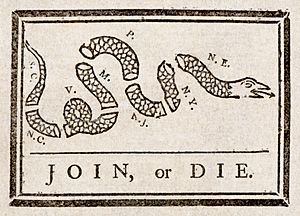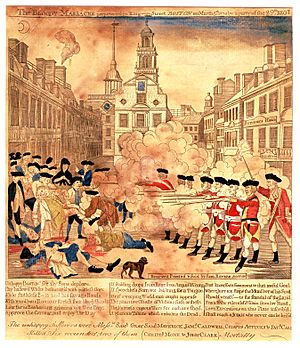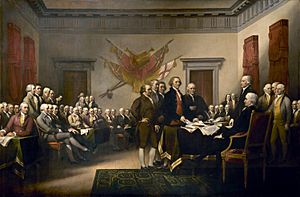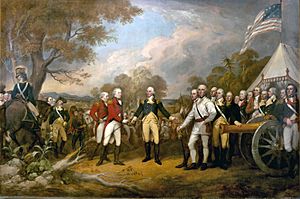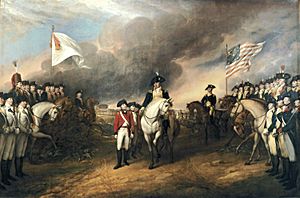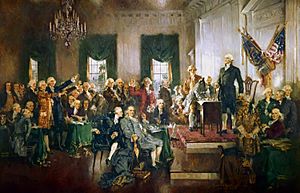Timeline of the American Revolution facts for kids
Timeline of the American Revolution – This is a timeline of the big changes that happened in the 1700s when the Thirteen Colonies in North America decided to become independent from the British Empire. After winning the Revolutionary War, these colonies joined together to form the United States of America.
The American Revolution involved political changes, social shifts, and military battles. This important time usually started with the Stamp Act in 1765 and ended when the United States Bill of Rights was approved in 1791. The actual fighting, the American Revolutionary War, lasted from 1775 to 1783.
Early Years: Seeds of Revolution (1600s)
British Control and Colonial Rights
- 1629: The Cambridge Agreement was signed.
- 1681: The British government, called the Lords of Trade, started trying to take back control of the colonies' special charters (their founding documents).
- 1684: Massachusetts lost its original charter from King Charles II. This meant the King had more direct control over the colony.
- 1686: A new British government, called the Dominion of New England, was set up in America.
- 1689: The 1689 Boston revolt happened. Leaders from the old Massachusetts Bay Colony took back control of their government. Other colonies also saw their old leaders return to power.
- 1691: King William III and Queen Mary II approved a new charter for the Province of Massachusetts Bay, officially creating it.
Growing Tensions: The Road to War (1750s-1760s)
First Steps Towards Unity (1750s)
- 1754: The Albany Congress took place from June 18 to July 11. This was the first time in the 1700s that representatives from American colonies met to talk about forming a union.
Britain's New Policies (1760s)
- 1760:
* Pierre de Rigaud, the Governor of New France, surrendered to British General Jeffrey Amherst on September 8. This ended most of the fighting between France and Great Britain in North America during the French and Indian War. * King George II of Great Britain died on October 25, and his grandson George III became the new king.
- 1761: Many New Englanders moved to Nova Scotia, Canada, to settle on lands left empty after the Expulsion of the Acadians.
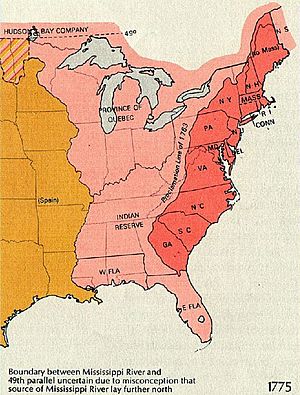
- 1763:
* The Treaty of Paris officially ended the French and Indian War on February 10. France gave most of its North American lands to Great Britain. * Native American tribes in the Great Lakes area, who had been allies with France, resisted British policies. Pontiac's Rebellion began and lasted until 1766. * King George's Royal Proclamation of 1763 on October 7 set up new rules for the lands Britain gained from France. To stop fighting between settlers and Native Americans, the Proclamation drew a western border for the American colonies. * The Navigation Acts, which controlled colonial trade, were enforced more strictly by George Grenville. This was part of Britain's effort to regain control over its economy after the Seven Years' War.
- 1764:
* Parliament passed the Sugar Act on April 5, which aimed to raise money, and the Currency Act on September 1, which stopped colonies from printing their own paper money. These acts made colonists angry and led to protests, especially during an economic slowdown after the French and Indian War.
- 1765:
* To help pay for British troops in America, Parliament passed the Stamp Act on March 22. This act put a tax on many printed materials in the colonies. Colonists saw this as unfair and protested strongly. Virginia's House of Burgesses adopted the Virginia Resolves on May 29, saying that Virginians could only be taxed by their own elected representatives. * Delegates from nine colonies attended the Stamp Act Congress, which adopted a Declaration of Rights and Grievances on October 19. They asked Parliament and the king to cancel the Stamp Act. * Parliament also passed the Quartering Act on March 24, which required colonies to provide housing, food, and supplies for British soldiers. Most colonies resisted this act.
- 1766:
* The British Parliament canceled the unpopular Stamp Act on March 18. However, at the same time, they passed the Declaratory Act, which stated that Parliament had "full power and authority to make laws" for the colonies "in all cases whatsoever." * A Liberty Pole was put up in New York City on May 21 to celebrate the Stamp Act being canceled.
- 1767:
* The Townshend Acts, named after Chancellor of the Exchequer Charles Townshend, were passed by Parliament on June 29. These acts placed taxes on many goods imported into America.
- 1768:
* In April, Lord Hillsborough, Britain's Secretary of State for the Colonies, ordered colonial governors to stop their assemblies from supporting Adams' circular letter, which protested the Townshend Acts. * In May, a British warship, HMS Romney, arrived in Boston Harbor after customs officials complained about being bothered by Boston protesters. * In June, customs officials seized John Hancock's ship, Liberty, after imported wine was unloaded illegally without paying taxes. After threats from Bostonians, the officials fled and asked for British troops to intervene. * In July, the governor of Massachusetts dissolved the general court because it refused to cancel Adams' circular letter. * In August, merchants in Boston and New York agreed to stop buying most British goods until the Townshend Acts were canceled. * In September, Boston residents were encouraged to arm themselves. Later that month, British warships arrived in Boston Harbor, and two regiments of British soldiers set up permanent residence to keep order.
- 1769:
* A protest paper called To the Betrayed Inhabitants of the City and Colony of New York was published by the local Sons of Liberty.
Escalating Conflict: The Fight for Freedom (1770s)
Early Clashes and Protests (1770-1773)
- 1770:
* The Golden Hill incident occurred on January 19, where British troops injured civilians, and one person died. * Lord North became the Prime Minister of Great Britain on January 28.
* The Boston Massacre happened on March 5, where British soldiers shot and killed several colonists.
- 1771:
* The Battle of Alamance took place in North Carolina on May 16.
- 1772:
* Samuel Adams organized the Committees of Correspondence, groups that shared information among the colonies. * The Pine Tree Riot occurred. * The Gaspee Affair happened on June 9, where colonists attacked and burned a British customs ship. * A British court ruled in Somerset v Stewart on June 22 that slavery was not supported by English law in England itself. * The Watauga Association in what would become Tennessee declared itself independent.
- 1773:
* Parliament passed the Tea Act on May 10. * The Association of the Sons of Liberty in New York was published on December 15. * The Boston Tea Party took place on December 16, where colonists dumped British tea into Boston Harbor to protest the Tea Act.
The Intolerable Acts and First Congress (1774)
- 1774: This was a very important year.
* Benjamin Franklin, Massachusetts' representative in London, was questioned by Parliament. * Lord Dunmore's War took place. * The British passed the Intolerable Acts, also known as the Coercive Acts, to punish Massachusetts for the Boston Tea Party. These included: * The Boston Port Act (March 31), which closed Boston Harbor. * The Administration of Justice Act (May 20). * The Massachusetts Government Act (May 20), which greatly reduced Massachusetts' self-government. * A second Quartering Act (June 2). * The Quebec Act. * The Powder Alarm occurred on September 1, when General Gage secretly raided the Cambridge powder magazine. * The First Continental Congress met from September 5 to October 26, with delegates from twelve colonies. * The Suffolk Resolves were adopted on September 9, calling for resistance to the Intolerable Acts. * The burning of the ship Peggy Stewart happened on October 19. * A Petition to the King was sent on October 26. * The Greenwich Tea Party took place on December 22.
The War Begins (1775)
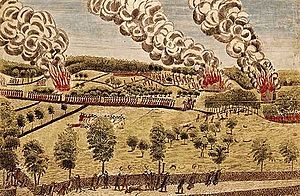
- 1775:
* The Battles of Lexington and Concord on April 19 marked the start of the Revolutionary War, followed by the Siege of Boston. * The Gunpowder Incident occurred on April 20. * Skenesboro, New York (now Whitehall, New York), was captured on May 9. * Fort Ticonderoga was captured by Ethan Allen, Benedict Arnold, and the Green Mountain Boys on May 10. * The Second Continental Congress met on May 10. * Congress voted to create the Continental Army from the militia units around Boston and appointed George Washington of Virginia as its commanding general on June 14. This army would later become the modern United States Army. * The Battle of Bunker Hill took place on June 17. * Washington arrived in Cambridge, Massachusetts, on July 2 to take command of the Continental Army. * The Declaration of the Causes and Necessity of Taking Up Arms was issued on July 6. * The Olive Branch Petition was sent to King George III on July 8, asking for peace. * Dunmore's Proclamation was issued by Lord Dunmore, the colonial governor of Virginia, on November 7. It offered freedom to enslaved people who left their Patriot masters and fought for the British. * The Continental Marines were established by the Continental Congress on November 10. They would become the modern United States Marine Corps. * The Battle of Kemp's Landing happened on November 15. * The Siege of Savage's Old Fields took place from November 19-21. * Henry Knox transported fifty-nine captured cannons from Fort Ticonderoga and Fort Crown Point to Boston, Massachusetts, a journey that took 56 days (December 5, 1775, to January 24, 1776). * The Battle of Great Bridge occurred on December 9. * British forces pushed back an attack by Continental Army generals Richard Montgomery and Benedict Arnold at the Battle of Quebec on December 31.
Declaring Independence and Early Battles (1776)
- 1776:
* New Hampshire approved its first state constitution. * The Burning of Norfolk happened on January 1. * Thomas Paine published Common Sense on January 10, a pamphlet arguing for independence. * Battle of Moore's Creek Bridge occurred on February 27. * The Fortification of Dorchester Heights from March 4-5 led to British forces leaving Boston. * The British evacuated Boston on March 17. * The Battle of Sullivan's Island took place on June 28. * The largest gathering of the British naval fleet in history began off the coasts of Staten Island, Brooklyn, and New Jersey on July 3.
* The Second Continental Congress passed a resolution declaring independence from the British Empire on July 2. They then approved the written Declaration of Independence on July 4. * The Sons of Liberty ordered the toppling of a statue of King George III in Bowling Green (New York City) on July 9. * The Battle of Long Island, also known as the Battle of Brooklyn, occurred on August 27. * British prison ships began holding American prisoners of war in Wallabout Bay, New York. * The Staten Island Peace Conference took place on September 11. * The Landing at Kip's Bay happened on September 15. * The Battle of Harlem Heights occurred on September 16. * The Great Fire of New York burned from September 21-22. * Nathan Hale was captured and executed for espionage on September 22. * The Battle of Valcour Island took place on October 11. * The Battle of White Plains occurred on October 29. * The Battle of Fort Washington happened on November 16. * The Battle of Fort Lee took place on November 20.
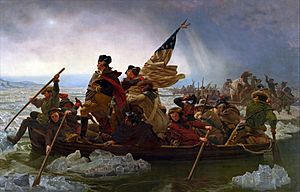
* The Battle of Trenton occurred on December 26, a key victory for Washington.
Turning Points and Hardships (1777)
- 1777:
* The Battle of the Assunpink Creek, also known as the Second Battle of Trenton, happened on January 2. * The Battle of Princeton took place on January 3. * The Continental Army entered its second winter camp at Morristown on January 6. * The Forage War (January–March) involved several smaller battles as Americans sought supplies. * Sybil Ludington, a 16-year-old, made a 40-mile ride on the night of April 26 to warn of a British attack. * British troops burned and looted Danbury, Connecticut, on April 26. * The Battle of Ridgefield occurred on April 27. * Fort Ticonderoga was abandoned by the Americans on July 5 because advancing British troops placed cannons on Mount Defiance. * The British retook Fort Ticonderoga on July 6. * The Battle of Hubbardton took place on July 7. * Delegates in Vermont, which was not one of the Thirteen Colonies, established a republic and adopted a constitution on July 8. This was the first constitution in what is now the U.S. to ban slavery. * The Battle of Bennington occurred on August 16. * The Battle of Brandywine took place on September 11. * The British occupied Philadelphia on September 26. * The Battle of Germantown happened on October 4.
* The two Battles of Saratoga (September 19 and October 7) ended with the surrender of the British army under General Burgoyne. This was a major turning point in the war. * The Articles of Confederation were adopted by the Second Continental Congress on November 15. * The Continental Army spent its third winter at Valley Forge from December 19 to June 19, 1778, enduring harsh conditions.
French Alliance and Western Battles (1778)
- 1778:
* The Treaty of Amity and Commerce and Treaty of Alliance were signed with France on February 6. This meant France officially recognized the U.S. and became an ally. * France was the first foreign country to recognize the flag of the United States on John Paul Jones's ship on February 14. * John Paul Jones, commanding the Ranger, attacked Whitehaven in England on April 20. This was America's first naval battle outside North America. * The Great Chain across the Hudson River was completed on April 30 to block British ships. * The British occupation of Philadelphia ended in June. * The Battle of Monmouth took place on June 28. * The Battle of Wyoming occurred on July 3. * The Battle of Rhode Island happened on August 29. * The Capture of Savannah on December 29 marked the successful start of the British southern strategy. * The majority of the Continental Army spent its fourth winter at Middlebrook Cantonment from November 30 to June 3, 1779.
Southern Campaigns and Treason (1779)
- 1779:
* The Battle of Kettle Creek took place on February 14. * The Siege of Fort Vincennes occurred from February 23-25. * Tryon's raid (July 3–July 14) involved British attacks and destruction in Connecticut, including the Battle of Fairfield on July 7. * The Battle of Stony Point happened on July 16. * The Penobscot Expedition took place from July 24 to August 14. * The Siege of Savannah occurred from September 16 to October 18. * The Continental Army spent its fifth winter at Morristown from December to May 1780.
Victory and New Nation (1780s)
Key Southern Battles (1780)
- 1780:
* January 15: Congress created the Court of Appeals in Cases of Capture to handle disputes over captured ships. * February 1: About 8,000 British forces under General Henry Clinton arrived in Charleston, South Carolina, from New York. * March 14: Spanish General Bernardo de Gálvez captured Fort Charlotte from the British, taking the port of Mobile. * March 29-May 12: The Siege of Charleston took place. * April 8: British forces under General Henry Clinton and Admiral Mariot Arbuthnot besieged Charleston, South Carolina. The city fell on May 12, a major American defeat. * May 29: The Battle of Waxhaws occurred, where British forces severely defeated American troops. * June 23: The Battle of Springfield stopped a British invasion of New Jersey, ending major fighting in the North. * August 16: The Battle of Camden resulted in a big British victory over American General Gates in South Carolina. * September 23: John André was captured, which exposed the treason of Benedict Arnold. * October 7: The Battle of Kings Mountain was a significant American victory in the South. * December: The Continental Army entered its sixth winter, with camps in New York and New Jersey.
The Final Push (1781)
- 1781:
* January 1-29: The Pennsylvania Line Mutiny occurred. * January 17: The Battle of Cowpens was a key American victory in the South. * March 1: The Articles of Confederation were officially approved. * March 15: The Battle of Guilford Court House took place. * September 5: The Battle of the Chesapeake was a crucial naval victory for the French, preventing British reinforcement at Yorktown. * September 6: The Battle of Groton Heights occurred. * September 8: The Battle of Eutaw Springs took place. * October 19: The British surrendered at Yorktown, marking the end of major fighting in the war. * December 31: The Bank of North America was established. * December: The Continental Army returned to its seventh winter camp.
Peace and Independence (1782-1783)
- 1782:
* February 27: The British House of Commons voted against continuing the war, unofficially recognizing American independence. * March 8: The Gnadenhutten massacre occurred. * November 30: Preliminary Articles of Peace were signed by British and American representatives. * December 14: The British evacuated Charleston, South Carolina. * December 27: The last skirmish of the conflict took place near Cedar Bridge Tavern in New Jersey.
- 1783:
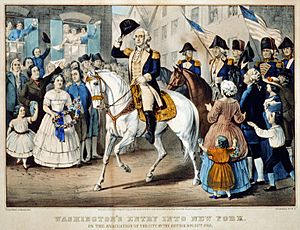
* March 10-15: The Newburgh Conspiracy occurred, where army officers considered rebelling over pay. * September 3: The Treaty of Paris (1783) officially ended the American Revolutionary War. * November 25: The British evacuated New York, ending British rule. General George Washington triumphantly returned with the Continental Army. * December 23: George Washington's resignation as commander-in-chief of the Continental Army.
Building a New Government (1784-1789)
- 1784:
* January 14: The Treaty of Paris was approved by the Congress. * April 9: The Treaty of Paris was approved by the British. * May 12: The approved treaties were exchanged in Paris.
- 1785:
* November 28: The Treaty of Hopewell was signed.
- 1786:
* Shays' Rebellion occurred, an uprising by farmers in Massachusetts. * The Annapolis Convention failed to achieve its goals.
- 1787:
* The Northwest Ordinance was passed, organizing new territories.
* The Constitutional Convention met in Philadelphia to write a new constitution. * Delaware, Pennsylvania, and New Jersey approved the new Constitution.
- 1788:
* Georgia, Connecticut, Massachusetts, Maryland, South Carolina, New Hampshire, Virginia, and New York approved the Constitution. * The United States Constitution was officially approved on June 21. * The first federal Elections for the House of Representatives began.
- 1789:
* March 4: Members of the 1st United States Congress began to take their seats in Federal Hall in New York. * April 6: Congress counted the votes from the Electoral College and confirmed that George Washington had been unanimously elected President of the United States. * April 30: George Washington was sworn in as the nation's first president at Federal Hall in New York City. * July 4: The Hamilton tariff was passed. * September 24: The Judiciary Act of 1789 was passed, setting up the federal court system. * September 25: Congress approved twelve articles of amendment to the Constitution. * November 21: North Carolina became the 12th state to approve the Constitution.
Establishing the Nation (1790s)
- 1791:
* December 15: The Bill of Rights was approved, adding important protections for individual freedoms to the Constitution.
- 1795:
* June: The Jay Treaty was approved, helping to resolve tensions between the United States and Great Britain after the Revolution.
- 1796:
* Six forts in the Northwest Territory and two in Upstate New York that were still under British control were given to the United States.
See also
 In Spanish: Anexo:Cronología de la historia de los Estados Unidos (1760-1789) para niños
In Spanish: Anexo:Cronología de la historia de los Estados Unidos (1760-1789) para niños


